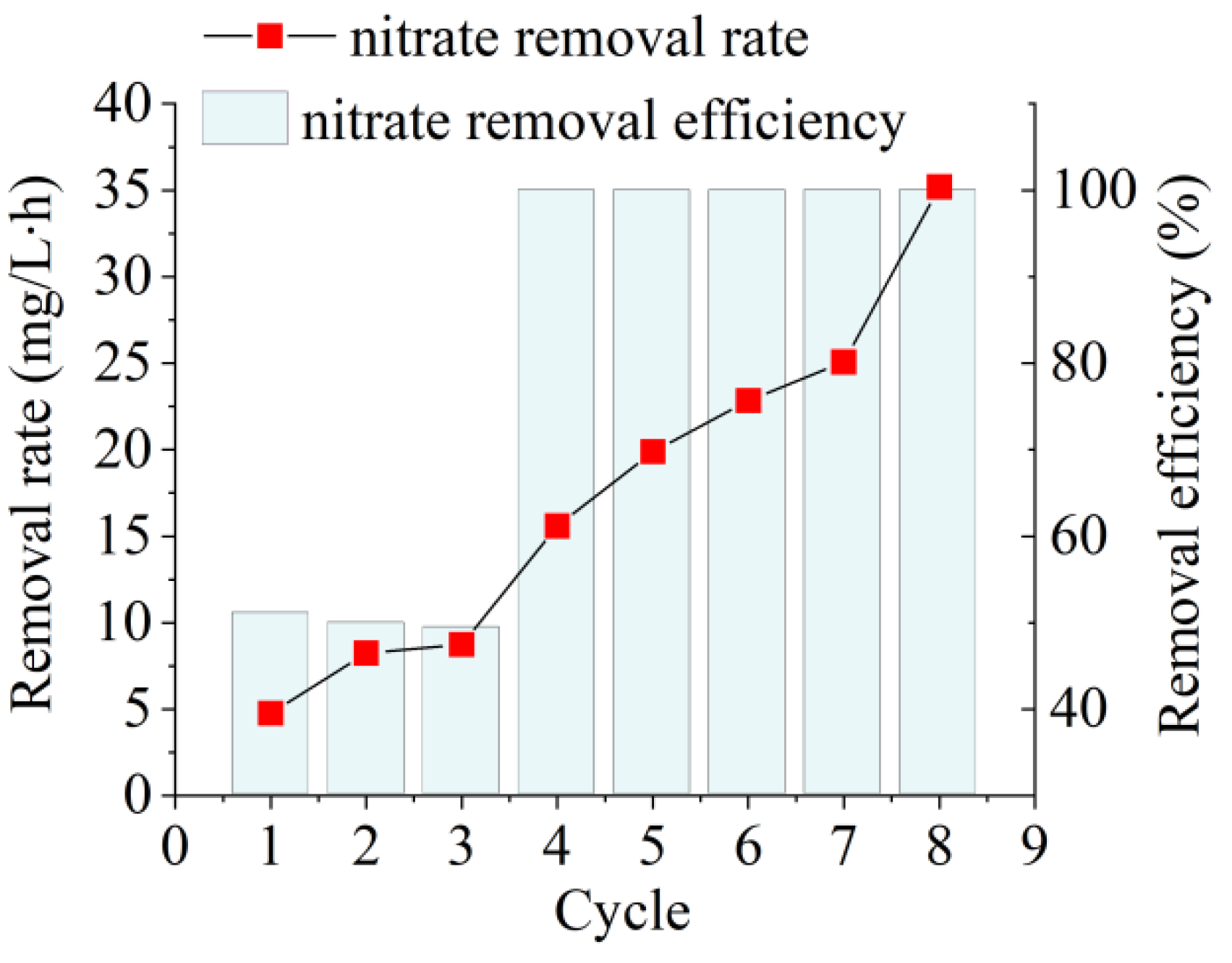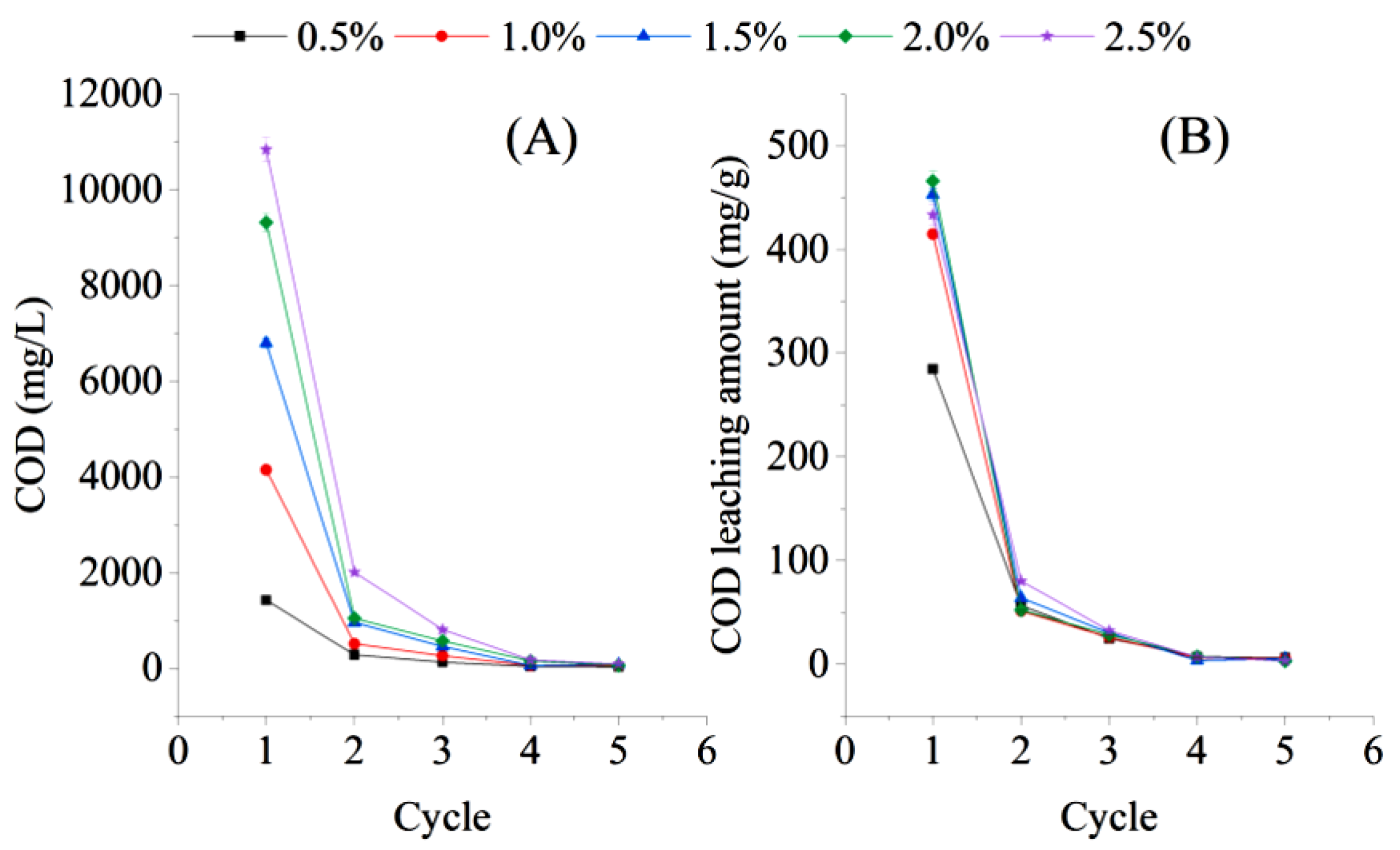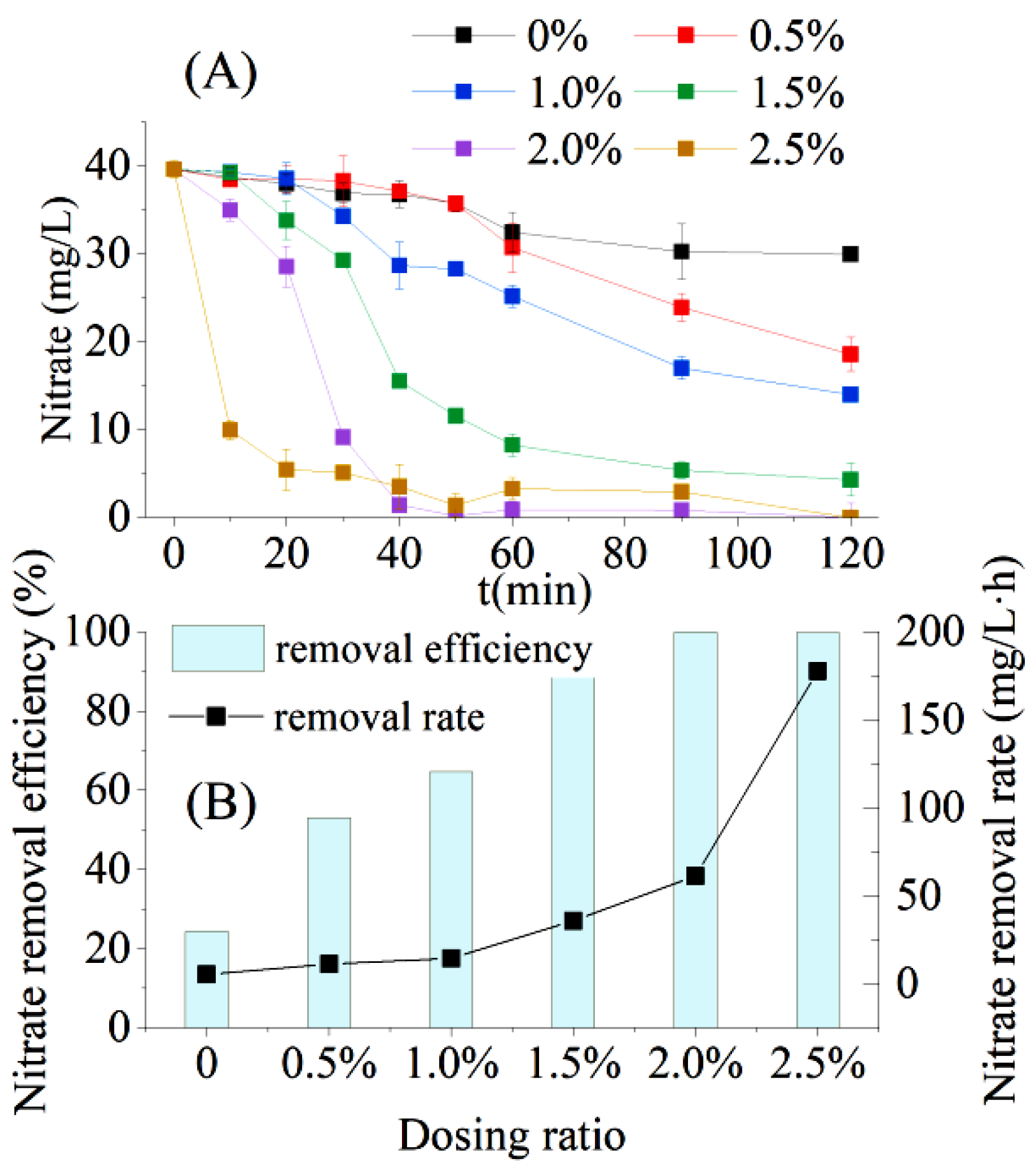Sugarcane Bagasse as Carbon Source and Filler to Enhance the Treatment of Low C/N Wastewater by Aerobic Denitrification Flora
Abstract
1. Introduction
2. Materials and Methods
2.1. Materials
2.1.1. Activated Sludge
2.1.2. Culture Media
2.1.3. Sugarcane Bagasse
2.1.4. Reactors
2.2. Methods
2.2.1. AD Flora Culture
2.2.2. Carbon-Release Performance Examination of Sugarcane Bagasse
- (1)
- Shake-flask experiment on soaking carbon release
- (2)
- Shake-flask experiment of batch water replacement
2.2.3. Enhanced Treatment of Low C/N Wastewater with Sugarcane Bagasse by AD Flora
- (1)
- Decarbonization of AD flora
- (2)
- Enhancement of denitrification by AD flora in sugarcane bagasse
2.2.4. Small-Scale Treatment of Low C/N Wastewater by Bagasse-Loaded SBBR
2.3. Parameter Analysis
2.4. Data Analysis
3. Results
3.1. Culture of AD Flora
3.2. Carbon Source Release from Sugarcane Bagasse
3.3. Enhanced Treatment of Low C/N Wastewater with Sugarcane Bagasse by AD Flora
3.4. Treatment of Low C/N Wastewater by AD Flora in Bagasse-Loaded SBBR
4. Discussion
5. Conclusions
Author Contributions
Funding
Institutional Review Board Statement
Informed Consent Statement
Data Availability Statement
Conflicts of Interest
References
- Yang, J.; Feng, L.; Pi, S.; Cui, D.; Ma, F.; Zhao, H.P.; Li, A. A critical review of aerobic denitrification: Insights into the intracellular electron transfer. Sci. Total Environ. 2022, 731, 139080. [Google Scholar] [CrossRef] [PubMed]
- Hao, Z.L.; Ali, A.; Ren, Y.; Su, J.F.; Wang, Z. A mechanistic review on aerobic denitrification for nitrogen removal in water treatment. Sci. Total Environ. 2022, 847, 157452. [Google Scholar] [CrossRef] [PubMed]
- Li, D.; Guo, W.; Liang, D.; Zhang, J.; Li, J.; Li, P.; Wu, Y.; Bian, X.; Ding, F. Rapid start-up and advanced nutrient removal of simultaneous nitrification, endogenous denitrification and phosphorus removal aerobic granular sequence batch reactor for treating low C/N domestic wastewater. Environ. Res. 2022, 212, 113464. [Google Scholar] [CrossRef] [PubMed]
- Hu, B.; Quan, J.; Huang, K.; Zhao, J.; Xing, G.; Wu, P.; Chen, Y.; Ding, X.; Hu, Y. Effects of C/N ratio and dissolved oxygen on aerobic denitrification process: A mathematical modeling study. Chemosphere 2021, 272, 129521. [Google Scholar] [CrossRef]
- Wang, X.J.; Wang, D.S.; Li, J.; Du, S.D.; Zhou, T.; Wu, G.D. Separation identification and the characteristics research of simultaneous removal of nitrogen and carbon about Marine heterotrophic nitrification and aerobic denitrification strain y6. China Environ. Sci. 2017, 37, 686–695. [Google Scholar] [CrossRef]
- Wiboonluk, P.; Cholticha, P.; Sorawit, P. Optimization and evaluation of a bottom substrate denitrification tank for nitrate removal from a recirculating aquaculture system. J. Environ. Sci. 2013, 25, 1557–1564. [Google Scholar] [CrossRef]
- Zhang, M.; Wang, Y.; Fan, Y.; Liu, Y.; Yu, M.; He, C.; Wu, J. Bioaugmentation of low C/N ratio wastewater: Effect of acetate and propionate on nutrient removal, substrate transformation, and microbial community behavior. Bioresour. Technol. 2019, 306, 122465. [Google Scholar] [CrossRef]
- Wang, J.; Chu, L. Biological nitrate removal from water and wastewater by solid-phase denitrification process. Biotechnol. Adv. 2016, 34, 1103–1112. [Google Scholar] [CrossRef]
- Fu, X.; Hou, R.; Yang, P.; Qian, S.; Feng, Z.; Chen, Z.; Wang, F.; Yuan, R.; Chen, H.; Zhou, B. Application of external carbon source in heterotrophic denitrification of domestic sewage: A review. Sci. Total Environ. 2022, 817, 153061. [Google Scholar] [CrossRef]
- Shi, Y.; Hu, Y.; Liang, D.; Wang, G.; Xie, J.; Zhu, X. Enhanced denitrification of sewage via bio-microcapsules embedding heterotrophic nitrification-aerobic denitrification bacteria Acinetobacter pittii SY9 and corn cob. Bioresour. Technol. 2022, 358, 127260. [Google Scholar] [CrossRef]
- Feng, L.; Pi, S.; Zhu, W.; Wang, X.; Xu, X. Nitrification and aerobic denitrification in solid phase denitrification systems with various biodegradable carriers for ammonium-contaminated water purification. J. Chem. Technol. Biotechnol. 2019, 94, 3569–3577. [Google Scholar] [CrossRef]
- Bilba, K.; Arsene, M.A. Silane treatment of bagasse fiber for reinforcement of cementitious composites. Compos. Part A Appl. Sci. Manuf. 2008, 39, 1488–1495. [Google Scholar] [CrossRef]
- Bao, G.Y.; Lan, Y.H. Sugarcane biorefinery—New development on utilization of bagasse. Sugarcane Canesugar. 2011, 5, 59–65. [Google Scholar] [CrossRef]
- Ajala, E.O.; Ighalo, J.O.; Ajala, M.A.; Adeniyi, A.G.; Ayanshola, A.M. Sugarcane bagasse: A biomass sufficiently applied for improving global energy, environment and economic sustainability. Bioresour. Bioprocess. 2021, 8, 87. [Google Scholar] [CrossRef]
- Hu, B.; Wang, T.; Ye, J.; Zhao, J.; Yang, L.; Wu, P.; Duan, J.; Ye, G. Effects of carbon sources and operation modes on the performances of aerobic denitrification process and its microbial community shifts. J. Environ. Manag. 2019, 239, 299–305. [Google Scholar] [CrossRef]
- Yang, X.R. Determination of COD by Doal-wavelength Equivalent Absorbance Spectrophotometry. J. Wuhan Univ. Technol. 2010, 32, 177–180. [Google Scholar] [CrossRef]
- Wang, J.; Rong, H.; Zhang, C. Evaluation of the impact of dissolved oxygen concentration on biofilm microbial community in sequencing batch biofilm reactor. J. Biosci. Bioeng. 2018, 125, 532–542. [Google Scholar] [CrossRef]
- Di, J.Z.; Li, T.D.; Zhao, W. Release law of sugarcane slag carbon source and orthogonal testing of sulfate-reducing bacteria. J. Agro-Environ. Sci. 2019, 38, 1151–1157. [Google Scholar] [CrossRef]
- Cao, X.; Li, Y.; Jiang, X.; Zhou, P.; Zhang, J.; Zheng, Z. Treatment of artificial secondary effluent for effective nitrogen removal using a combination of corncob carbon source and bamboo charcoal filter. Int. Biodeterior. Biodegrad. 2016, 115, 164–170. [Google Scholar] [CrossRef]
- Pan, Z.; Zhou, J.; Lin, Z.; Wang, Y.; Zhao, P.; Zhou, J.; Liu, S.; He, X. Effects of COD/TN ratio on nitrogen removal efficiency, microbial community for high saline wastewater treatment based on heterotrophic nitrification-aerobic denitrification process. Bioresour. Technol. 2020, 301, 122726. [Google Scholar] [CrossRef]
- Wang, T.; Chen, M.; Liang, X.; Chen, F.; He, T.; Li, Z. Corrigendum: The alkali-tolerant bacterium of Bacillus thuringiensis EM-A1 can effectively perform heterotrophic nitrification and aerobic denitrification. Front. Environ. Sci. 2022, 19, 818316. [Google Scholar] [CrossRef]
- Su, J.F.; Ma, M.; Ma, F.; Lu, J.S. Kinetic analysis of heterotrophic nitrification -aerobic denitrification by an oligotrophic Acinetobacter sp. SYF26. Environ. Eng. Sci. 2017, 34, 844–851. [Google Scholar] [CrossRef]
- Prangya, R.R.; Puspendu, B.; Rajesh, R.D. Simultaneous removal of nitrogen and phosphorous from domestic wastewater using Bacillus cereus GS-5 strain exhibiting heterotrophic nitrification, aerobic denitrification and denitrifying phosphorous removal. Bioresour. Technol. 2017, 244, 484–495. [Google Scholar] [CrossRef]
- Zeng, M.; Zeng, Y.; Zhang, B.; Cheng, Y.; Long, B.; Wu, J.; Ren, S.; Liu, Y. Coupling of endogenous/exogenous nitrification and denitrification in an aerobic granular sequencing batch reactor. Environ. Technol. 2022, 20, 68380. [Google Scholar] [CrossRef] [PubMed]
- Shi, L.; Ma, B.; Li, X.; Zhang, Q.; Peng, Y. Advanced nitrogen removal without addition of external carbon source in an anaerobic/aerobic/anoxic sequencing batch reactor. Bioprocess Biosyst. Eng. 2019, 42, 1507–1515. [Google Scholar] [CrossRef] [PubMed]
- Tao, L.; Xiao, L.Y.; Hai, L.S.; Jia, J.W.; Jia, Y.X. Alkali-treated cellulose carrier enhancing denitrification in membrane bioreactor. Int. Biodeter. Biodegr. 2019, 145, 104813. [Google Scholar] [CrossRef]
- Cui, Y.; Zhao, B.; Xie, F.; Zhang, X.; Zhou, A.; Wang, S.; Yue, X. Study on the preparation and feasibility of a novel adding-type biological slow-release carbon source. J. Environ. Manag. 2022, 316, 115236. [Google Scholar] [CrossRef]
- Simon, A.; Luca, Q.; Bert, G.; Inez, D.; Simon, B.; Monica, A.; Tomas, A.; Fernando, M.; Anton, K.; Markus, H.; et al. Integration of biopolymer production with process water treatment at a sugar factory. New Biotechnol. 2014, 31, 308–323. [Google Scholar] [CrossRef]
- Zhao, Y.; Wang, J.; Liu, Z.; Yang, W.; Hu, J.; Jia, Z.; Hu, B. Biofilm: A strategy for the dominance of comammox Nitrospira. J. Clean. Prod. 2022, 363, 132316. [Google Scholar] [CrossRef]
- Chang, J.; Ma, L.; Zhou, Y.; Zhang, S.; Wang, W. Remediation of nitrate-contaminated wastewater using denitrification biofilters with straws of ornamental flowers added as carbon source. Water Sci. Technol. 2016, 74, 416–423. [Google Scholar] [CrossRef]
- Yang, Y.; Lin, E.; Sun, S.; Tao, X.; Zhong, L.; Hu, K. Piggery wastewater treatment by Acinetobacter sp. TX5 immobilized with spent mushroom substrate in a fixed-bed reactor. Sci. Total Environ. 2018, 644, 1460–1468. [Google Scholar] [CrossRef] [PubMed]
- Zhang, W. The Research and Application of Sustainable Long-release Carbon Material with Agricultural Waste. Ph.D. Thesis, Nanjing University, Nanjing, China, January 2017. [Google Scholar] [CrossRef]
- Zhong, S.Q.; Yang, Y.; Tao, R.; Li, L.; Zhang, M.; Zhao, J.C. Carbon releasing characteristics and denitrification effects of five plant materials. Chin. J. Environ. Eng. 2014, 8, 1817–1824. Available online: http://www.cjee.ac.cn/article/id/20140520?viewType=HTML (accessed on 1 September 2022).
- Wang, P.C. Performance of Nitrogen and Antibiotics Removal from the Effluent of Wastewater Treatment Plants by Biomass-iron Mixture Denitrification Biological Filter. Master’s Thesis, East China Normal University, Shanghai, China, May 2021. [Google Scholar] [CrossRef]
- Sun, F. The Study on the Improving Technology of Nitrogen and Phosphorus Removal Efficiency in Biofiltration System by Different’ Electron Donors. Master’s Thesis, Huazhong Agricultural University, Wuhan, China, June 2021. [Google Scholar] [CrossRef]
- Sareh, T.; Hadi, M.; Abd, A.N.; Seyyed, E.H.G.; Saeed, B.; Amit, B. Investigation on the performance of sugarcane bagasse as a new carbon source in two hydraulic dimensions of denitrification beds. J. Clean. Prod. 2017, 140, 1176–1181. [Google Scholar] [CrossRef]
- Cui, H. A Tubular Bio-reactor Device Used for Enhancing Denitrification of the Effluent from Rural Wastewater Treatment Facilities and the Demonstration Project. Ph.D. Thesis, East China Normal University, Shanghai, China, May 2019. [Google Scholar]






| Item | Length (mm) | Width (mm) | Thickness (mm) | Mass (g) |
|---|---|---|---|---|
| Average value (mean) | 26.60 | 17.48 | 6.32 | 0.27 |
| Standard deviation (SD) | 7.76 | 4.43 | 2.47 | 0.15 |
| Dosing Ratio | 0% | 0.5% | 1.0% | 1.5% | 2.0% | 2.5% | |
|---|---|---|---|---|---|---|---|
| First-order | k1 (min−1) | 0.0371 | 0.0416 | 0.0761 | 0.0780 | 0.0418 | 0.0040 |
| Intercept | −0.3340 | −0.6204 | −1.3069 | −0.5377 | 1.5911 | 3.4074 | |
| R2 | 0.9518 | 0.8860 | 0.8634 | 0.7805 | 0.7742 | 0.7338 | |
| Second-order | k2 (L·mg−1·s−1) | −0.0169 | −0.0172 | −0.0494 | −0.0362 | −0.0033 | −0.0001 |
| Intercept | 1.0356 | 1.1221 | 2.4313 | 1.7149 | 0.1590 | 0.0078 | |
| R2 | 0.8246 | 0.9102 | 0.6327 | 0.4772 | 0.6553 | 0.7217 | |
Publisher’s Note: MDPI stays neutral with regard to jurisdictional claims in published maps and institutional affiliations. |
© 2022 by the authors. Licensee MDPI, Basel, Switzerland. This article is an open access article distributed under the terms and conditions of the Creative Commons Attribution (CC BY) license (https://creativecommons.org/licenses/by/4.0/).
Share and Cite
Chen, M.; Tang, Q.; Zou, J.; Lv, X.; Deng, Y.; Ma, X.; Ma, S. Sugarcane Bagasse as Carbon Source and Filler to Enhance the Treatment of Low C/N Wastewater by Aerobic Denitrification Flora. Water 2022, 14, 3355. https://doi.org/10.3390/w14213355
Chen M, Tang Q, Zou J, Lv X, Deng Y, Ma X, Ma S. Sugarcane Bagasse as Carbon Source and Filler to Enhance the Treatment of Low C/N Wastewater by Aerobic Denitrification Flora. Water. 2022; 14(21):3355. https://doi.org/10.3390/w14213355
Chicago/Turabian StyleChen, Maoxia, Qiong Tang, Jiawei Zou, Xiaoyu Lv, Yu Deng, Xuguang Ma, and Shichun Ma. 2022. "Sugarcane Bagasse as Carbon Source and Filler to Enhance the Treatment of Low C/N Wastewater by Aerobic Denitrification Flora" Water 14, no. 21: 3355. https://doi.org/10.3390/w14213355
APA StyleChen, M., Tang, Q., Zou, J., Lv, X., Deng, Y., Ma, X., & Ma, S. (2022). Sugarcane Bagasse as Carbon Source and Filler to Enhance the Treatment of Low C/N Wastewater by Aerobic Denitrification Flora. Water, 14(21), 3355. https://doi.org/10.3390/w14213355






